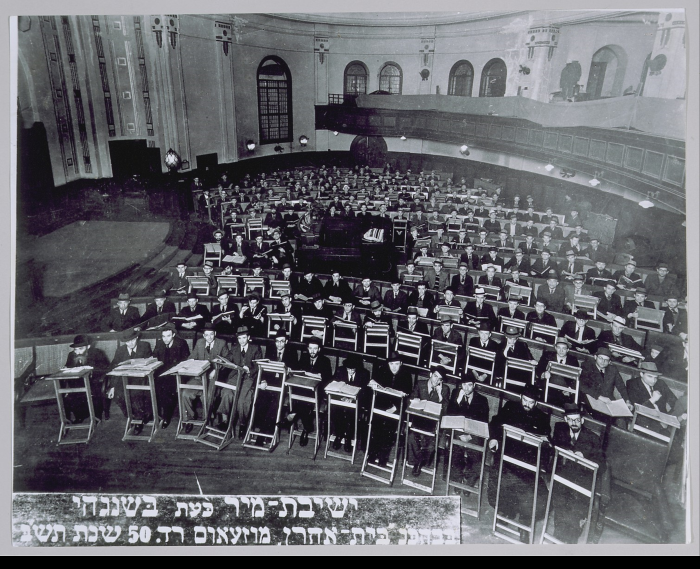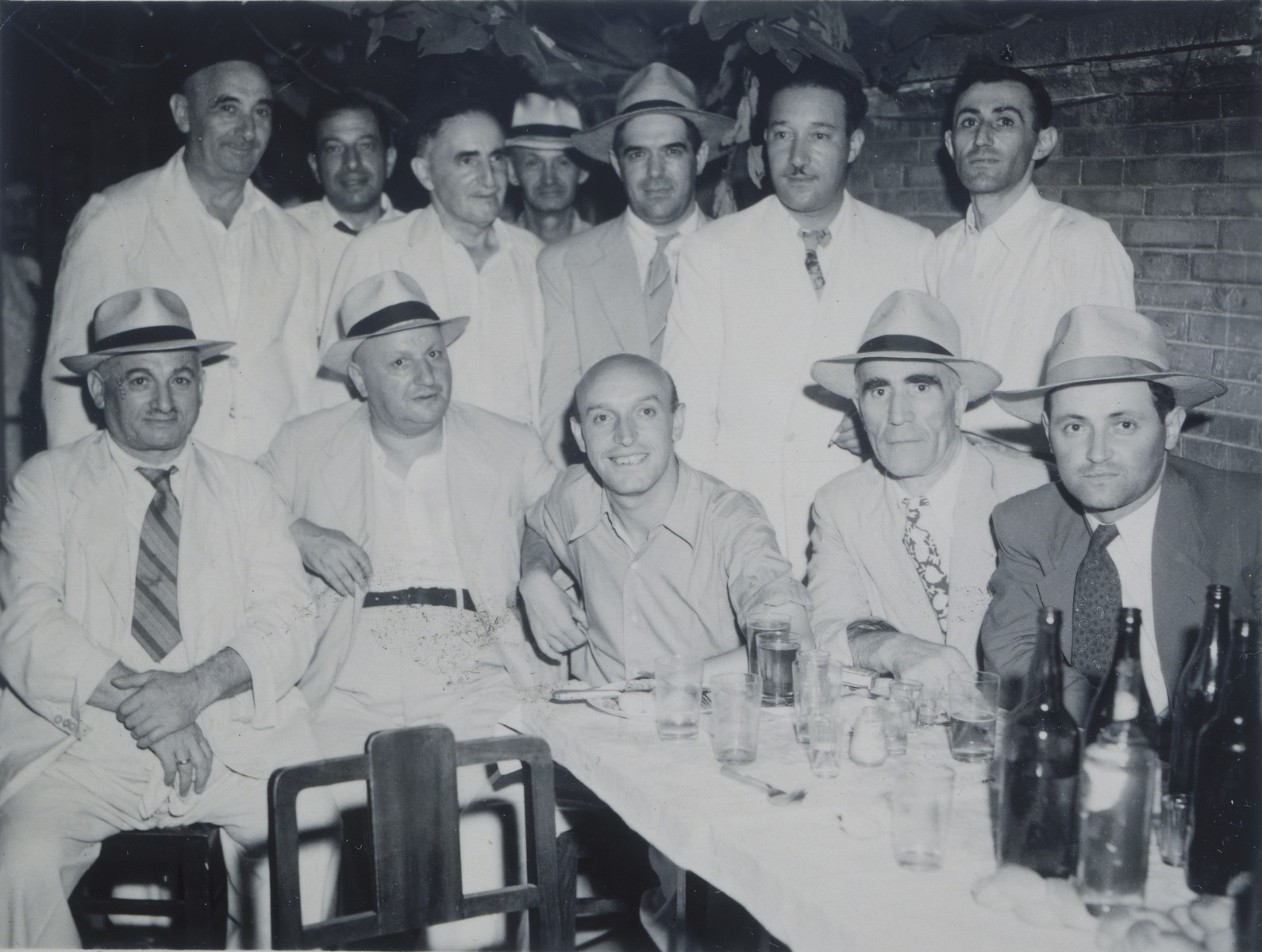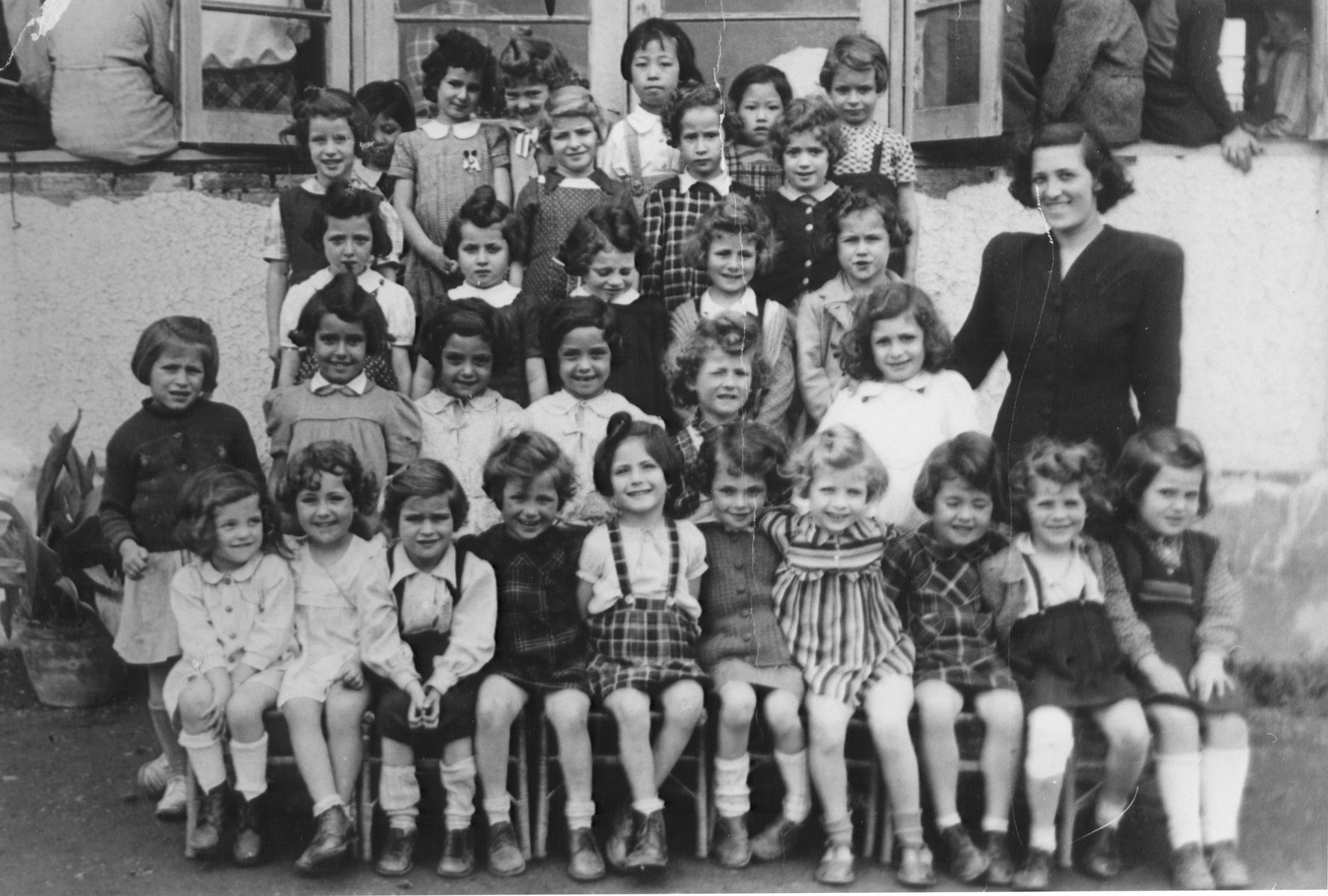Silas’s Folly: The Beth Aharon Synagogue in Shanghai and how it Saved the
Mirrer Yeshiva
By Vera Schwarcz1

Students and teachers of the exiled
Mir yeshiva study in the sanctuary of the Beth Aharon synagogue on
Museum Road in Shanghai, 1941.
USHMM photo archives, courtesy of Rabbi Jacob Ederman
The famous photograph of more than two hundred young men of the Mirrer Yeshiva standing and learning Torah in Shanghai brings the ancient maxim from Talmud Yerushalmi to life in a vivid fashion. Here was a strange and unexpected setting: the Beth Aharon Synagogue built in 1927 by Silas Hardoon (1851-1931), a thoroughly assimilated business tycoon, in memory of his father, Aharon. Silas Hardoon himself had no interest in Talmudic scholarship and had died before the war, never imagining that his momentary tribute to his father’s Jewish tradition would shelter and enliven Torah learning during the European Holocaust.
As a child, Chaya Leah understood little about the financial and political complexities that enabled the Mirrer Yeshiva to survive. She was an innocent runner of ‘lokshen’ to and from the black market, without realizing that this was currency, not food. Looking at the girl who had empathized with the orphaned bochrim [yeshiva students], who sensed their hidden and not so hidden ailments and grief, she too marvels at the Mirrer Yeshiva photograph. In her eyes, the survival of this singular institution of higher Jewish learning is a concrete testament to a complex tapestry that providence weaves out of the folly of men:
The master plan is executed when we do something that is not the norm. We wonder what prompted us to do it. But there is a reason for everything. Silas Hardoon, who was brought in from Iraq by the Sassoon family to help manage their real estate business, succeeded beyond belief on his own. His personal real estate business grew into a huge enterprise. The Kadoories and the Sassoons built synagogues in Shanghai and Hongkong in memory of their parents. The story goes that Silas Hardoon’s father appeared to him in a dream and he asked him to build a shul. Silas does not build the shul in the center of town, but way out from the reasonable and accessible location for the public. The shul had two hundred and fifty seats, a huge kitchen and dining hall. But the shul was empty for years.
Chaya Leah’s recollection draws upon some of the memoirs written by friends of Rav Shmuel David from the Shanghai years. The details about the number of seats and the two kosher kitchens inside the Beth Aharon synagogue can be found in other accounts by some of the young men who were in the photograph. The history of the ‘Baghdadi Jews’—the highly Anglicized elite that accompanied British imperialism into China –is recorded more fully by scholars such as Maisie Meyer2, among others. What is striking in Chaya Leah’s backward glance is the effort to make sense out of the unexpected turn of events in Shanghai. What she senses as ‘the master plan’ appeared to the child in odd, strange fragments.
Silas’s folly.
When the Mirrer Yeshiva came to Shanghai, they occupied the shul, which became a beth medrash. There were exactly 252 seats, and exactly 252 yeshiva bochrim. The kitchens were used to feed the needy. Is this Silas’s folly or is it Yad Hashem?

A group of Mir Yeshiva students pose with an American chaplain in Shanghai. USHMM photo archives. Courtesy of Rabbi Jacob Ederman.

Group portrait of members of the Mir Yeshiva. USHMM photo archives. Courtesy of Chaim Cohen.
There is a quality of the fabulous in this recollection, as in the writings of other impoverished refugees who encountered the grandiose wealth of the Sephardi families in Shanghai. One can almost see the little girl in awe of tales told around the family table about the palaces of the wealthy magnates, which her own father visited more than once in an effort to raise funds to help support the Polish Jews.
But there is more here than dazzling riches, and a case of inadvertent generosity that helped to save the entire Mirrer Yeshiva. Chaya Leah, looking back, is asking a profound question. Instead of simply asserting that it was Divine Providence that accomplished the Mirrer ‘miracle’, she tries to fathom more deeply the source and consequences of human action. Like the Sugihara visas, this salvation too depended on doing something that was not the norm. In Chaya Leah’s view, it is through human actions that providence is revealed most concretely and most interestingly.
Silas Aaron Hardoon, as Chaya Leah knew even as a little girl, was the least likely benefactor of Torah learning Jews. He, along with his Eurasian wife, Luo Jialing, inhabited the extravagantly posh Aili Garden estate where Buddhist priests and Chinese generals were more likely to visit than any Polish rabbi. Hardoon’s philanthropy also extended to children of all races. He and Luo adopted some eleven foreign children, some of them Jewish, who had been abandoned by impoverished Russian families when they fled the Bolshevik Revolution in 1917. Orphans from displaced Chinese families went on to take Luo Jialing’s last name. At the time of his death in 1931, Silas Hardoon was reputed to be the richest individual foreigner in East Asia. He owned valuable land along Nanking Road, Shanghai’s fashionable commercial thoroughfare, a shopping area comparable to London’s Oxford Street and New York’s Fifth Avenue.
Hardoon’s funeral rites were orchestrated by Buddhist and Daoist clergy. So where did the ‘miracle’ that helped the Mirrer Yeshiva come from? Most biographies speak of a dream that the Baghdad-born magnate had of his parents. Having strayed far from his religious roots, he wanted to do something to appease his ancestors—a thoroughly Chinese and also Jewish act of filial piety. Silas Hardoon commissioned the spacious Beth Aharon Synagogue during the last decade of his life and there is no evidence that he ever made use of the space for Jewish worship. Yet fourteen years after its completion, when the Mirrer Yeshiva arrived from Kobe, Rabbi Ashkenazi managed to secure the Beth Aharon structure for their learning. Its large, gracious interior became a Beit Midrash—hall of study where words of Torah became more precious because of the strangeness of China and the war roiling loudly outside.

First grade class of the Kadoorie School in Shanghai, 1945. USHMM photo archives, courtesy of Sonja Muhlberger
Chaya Leah’s question stands: was it folly or Yad Hashem—God’s hand in human affairs? Without the need to reference academic theories of agency, her answer is clearly both. We have few means to understand the purpose of our own actions. A glimmer of their significance appears only in retrospect and only when the predictable pattern of events takes an unexpected turn. The fact that Silas Hardoon and Luo Jialing adopted stray children and created a school in their ample mansion made ‘sense.’ Building a religious structure suited for Jewish orthodox worship did not.
Both as a child and as an experienced rebbetzen, Chaya does not jump to religious conclusions readily. She remains mindful of the marvels of rescue that marked her family’s life and that of the Jewish people. But there is no presumption here—only gratitude and willingness to allow the retrospective gaze to weave a fabric of meaning out of the unlikely occurrences that dotted life in Shanghai, and beyond.
1 This is an extract from Vera Schwarcz’s book, reproduced by kind permission of the author, In the Crook of the Rock: Jewish Refuge in a World Gone Mad: The Chaya Leah Walkin Story (Boston: Academic Studies Press, 2018). The book is based on interviews (and the journal) of Chaya Leah Walkin, a rabbi’s daughter who was a child refugee from Poland in Shanghai during the war years, and later a rebbetzin (eminent rabbi’s wife). Silas Hardoon was a wealthy Jew of Iraqi ancestry who built an enormous synagogue which remained empty for fourteen years, until it allowed the reconstitution and revival of the famous Mirrer Yeshiva in Shanghai. Vera Schwarcz, of Romanian origin, is an emeritus professor of Jewish studies and Chinese studies who has taught at Wesleyan University and the Hebrew University of Jerusalem for four decades. She is the author of six books of poetry and nine books of Jewish and Chinese history. The editors thank Vera Schwarcz and Academic Studies Press for allowing us to print this excerpt of her book.
2 see, Shanghai's Baghdadi Jews: A Collection of Biographical Reflections. 2015. London: Blacksmith Books and From the Rivers of Babylon to the Whangpoo: A Century of Sephardi Jewish Life in Shanghai. 2003. New York: University Press of America, ed.
Copyright by Sephardic Horizons, all rights reserved. ISSN Number 2158-1800
